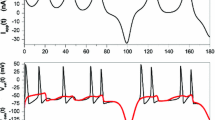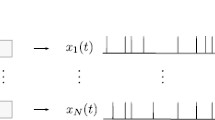Abstract
We provide rigorous and exact results characterizing the statistics of spike trains in a network of leaky Integrate-and-Fire neurons, where time is discrete and where neurons are submitted to noise, without restriction on the synaptic weights. We show the existence and uniqueness of an invariant measure of Gibbs type and discuss its properties. We also discuss Markovian approximations and relate them to the approaches currently used in computational neuroscience to analyse experimental spike trains statistics.
Similar content being viewed by others

References
Adrian E, Zotterman Y (1926) The impulses produced by sensory nerve endings. Part II: the response of a single end organ. J Physiol (Lond) 61: 151–171
Benda J, Herz A (2003) A universal model for spike-frequency adaptation. Neural Computtion 15(11): 2523–2564
Benda J, Longtin A, Maler L (2005) Spike-frequency adaptation separates transient communication signals from background oscillations. J Neurosci 25: 2312–2321
Bowen R (2008) Equilibrium states and the ergodic theory of Anosov diffeomorphisms, 2nd revised version. In: Lecture notes in mathematics, vol 470. Springer-Verlag
Bressaud X, Fernandez R, Galves A (1999) Decay of correlations for non hölderian dynamics. A coupling approach. Electron J Probab 4(3): 1–19
Brunel N, Hakim V (1999) Fast global oscillations in networks of integrate-and-fire neurons with low firing rates. Neural Comput 11: 1621–1671
Cessac B (2008) A discrete time neural network model with spiking neurons I. Rigorous results on the spontaneous dynamics. J Math Biol 56(3): 311–345
Cessac B, Sepulchre J (2004) Stable resonances and signal propagation in a chaotic network of coupled units. Phys Rev E 70: 056111
Cessac B, Sepulchre J (2006) Transmitting a signal by amplitude modulation in a chaotic network. Chaos 16: 013104
Cessac B, Viéville T (2008) On dynamics of integrate-and-fire neural networks with adaptive conductances. Front Neurosci 2(2): 1–20
Cessac B, Rostro-Gonzalez H, Vasquez J, Viéville T (2009) How gibbs distribution may naturally arise from synaptic adaptation mechanisms: a model based argumentation. J Stat Phys 136(3): 565–602
Chazottes J (1999) Entropie relative, dynamique symbolique et turbulence. PhD thesis, Université de Provence-Aix Marseille I
Chazottes J, Keller G (2009) Pressure and equilibrium states in ergodic theory. In: Ergodic theory. Encyclopedia of complexity and system science. Springer, Berlin (to appear)
Coelho Z, Quas A (1998) Criteria for d-continuity. Trans Am Math Soc 350(8): 3257–3268
Crook S, Ermentrout G, Bower J (1998) Spike frequency adaptation affects the synchronization properties of networks of cortical oscillators. Neural Comput 10(4): 837–854
Csiszar I (1984) Sanov property, generalized i-projection and a conditional limit theorem. Ann Prob 12(3): 768–793
Dayan P, Abbott LF (2001) Theoretical neuroscience: computational and mathematical modeling of neural systems. MIT Press, Cambridge
Ermentrout B, Pascal M, Gutkin B (2001) The effects of spike frequency adaptation and negative feedback on the synchronization of neural oscillators. Neural Comput 13(6): 1285–1310
Gantmacher FR (1998) The theory of matrices. AMS Chelsea Publishing, Providence
Gerstner W, Kistler W (2002a) Spiking neuron models. Cambridge University Press, Cambridge
Gerstner W, Kistler WM (2002b) Mathematical formulations of hebbian learning. Biol Cybern 87: 404–415
Grammont F, Riehle A (1999) Precise spike synchronization in monkey motor cortex involved in preparation for movement. Exp Brain Res 128: 118–122
Grammont F, Riehle A (2003) Spike synchronization and firing rate in a population of motor cortical neurons in relation to movement direction and reaction time. Biol Cybern 88: 360–373
Izhikevich E (2004) Which model to use for cortical spiking neurons? IEEE Trans Neural Netw 15(5): 1063–1070
Jaynes E (1957) Information theory and statistical mechanics. Phys Rev 106: 620
Johansson A, Oberg A (2003) Square summability of variations of g-functions and uniqueness of g-measure. Math Res Lett 10: 587–601
Jolivet R, Lewis T, Gerstner W (2004) Generalized integrate-and-fire models of neuronal activity approximate spike trains of a detailed model to a high degree of accuracy. J Neurophysiol 92: 959–976
Jolivet R, Rauch A, Lscher H-R, Gerstner W (2006) Predicting spike timing of neocortical pyramidal neurons by simple threshold models. J Comput Neurosci 21: 35–49
Keane M (1972) Strongly mixing g-measures. Invent Math 16: 309–324
Keller G (1998) Equilibrium states in ergodic theory. Cambridge University Press, Cambridge
Kirst C, Geisel T, Timme M (2009) Sequential desynchronization in networks of spiking neurons with partial reset. Phys Rev Lett 102: 068101
Kitchens BP (1998) Symbolic dynamics: one-sided, two-sided and countable state Markov shifts. Springer-Verlag, New York
Lapicque L (1907) Recherches quantitatives sur l’excitation électrique des nerfs traitée comme une polarisation. J Physiol Pathol Gen 9: 620–635
Ledrappier F (1974) Principe variationnel et systèmes dynamiques symboliques. Z Wahr verw Gebiete 30(185): 185–202
Maillard G (2007) Introduction to chains with complete connections. Ecole Federale Polytechnique de Lausanne, winter 2007
Marre O, Boustani SE, Frégnac Y, Destexhe A (2009) Prediction of spatiotemporal patterns of neural activity from pairwise correlations. Phys Rev Lett 102: 138101
Nirenberg S, Latham P (2003) Decoding neuronal spike trains: how important are correlations. Proc Nat Acad Sci 100(12): 7348–7353
Onicescu O, Mihoc G (1935) Sur les chaînes statistiques. C R Acad Sci Paris 200
Perrinet L (2008) Sparse spike coding: applications of neuroscience to the processing of natural images. In: Society of Photo-Optical Instrumentation Engineers (ed) Proceedings of SPIE, the International Society for Optical Engineering, number ISSN 0277-786X CODEN PSISDG, Bellingham, WA, ETATS-UNIS
Pouzat C, Chaffiol A (2009) On goodness of fit tests for models of neuronal spike trains considered as counting processes. http://arxiv.org/abs/0909.2785v1
Rieke F, Warland D, de Ruyter van Steveninck R, Bialek W (1996) Spikes, exploring the neural code. MIT Press, Cambridge
Riehle A, Grammont F, Diesmann M, Grün S (2000) Dynamical changes and temporal precision of synchronized spiking activity in monkey motor cortex during movement preparation. J Physiol (Paris) 94: 569–582
Roudy Y, Nirenberg S, Latham P (2009) Pairwise maximum entropy models for studying large biological systems: when they can work and when they can’t. PLOS Comput Biol 5(5): e1000380
Rudolph M, Destexhe A (2006) Analytical integrate and fire neuron models with conductance-based dynamics for event driven simulation strategies. Neural Comput 18: 2146–2210
Ruelle D (1969) Statistical mechanics: rigorous results. Benjamin, New York
Ruelle D (1978) Thermodynamic formalism. Addison-Wesley, Reading
Ruelle D (1999) Smooth dynamics and new theoretical ideas in nonequilibrium statistical mechanics. J Stat Phys 95: 393–468
Rullen RV, Thorpe S (2001) Rate coding versus temporal order coding: what the retina ganglion cells tell the visual cortex. Neural Comput 13(6): 1255–1283
Schneidman E, Berry M, Segev R, Bialek W (2006) Weak pairwise correlations imply string correlated network states in a neural population. Nature 440: 1007–1012
Seneta E (2006) Non-negative matrices and Markov chains. Springer, New York
Sinai Y (1972) Gibbs measures in ergodic theory. Russ Math Surveys 27(4): 21–69
Soula H, Beslon G, Mazet O (2006) Spontaneous dynamics of asymmetric random recurrent spiking neural networks. Neural Comput 18(1): 60–79
Thorpe S (1990) Spike arrival times: a highly efficient coding scheme for neural networks. In: Parallel processing neural systems and computers, pp 91–94
Thorpe S, Fize D, Marlot C (1996) Speed of processing in the human visual system. Nature 381: 520–522
Tkacik G, Schneidman E, Berry M, Bialek W (2006) Ising models for networks of real neurons. arXiv: q-bio/0611072
Touboul J, Faugeras O (2007) The spikes trains probability distributions: a stochastic calculus approach. J Physiol (Paris) 101(1–3): 78–98
Touboul J, Faugeras O (2009) A markovian event-based framework for stochastic spiking neural networks. Technical report, arXiv, 2009. Neural Comput (submitted)
Toyoizumi T, Pfister J-P, Aihara K, Gerstner W (2007) Optimality model of unsupervised spike-timing dependent plasticity: synaptic memory and weight distribution. Neural Comput 19: 639–671
Vasquez J, Cessac B, Vieville T (2010) Entropy-based parametric estimation of spike train statistics. J Comput Neurosci (submitted)
Author information
Authors and Affiliations
Corresponding author
Rights and permissions
About this article
Cite this article
Cessac, B. A discrete time neural network model with spiking neurons: II: Dynamics with noise. J. Math. Biol. 62, 863–900 (2011). https://doi.org/10.1007/s00285-010-0358-4
Received:
Revised:
Published:
Issue Date:
DOI: https://doi.org/10.1007/s00285-010-0358-4



